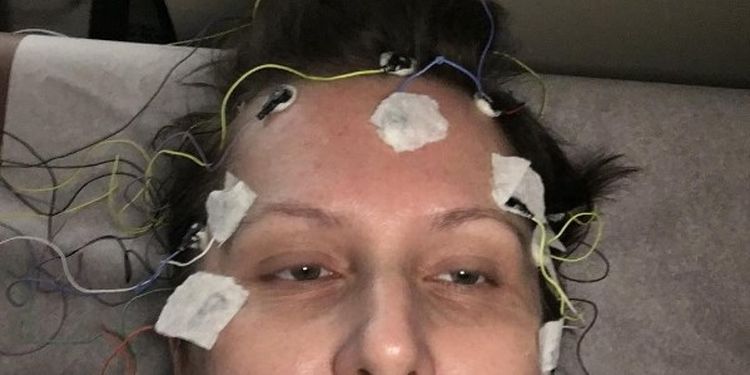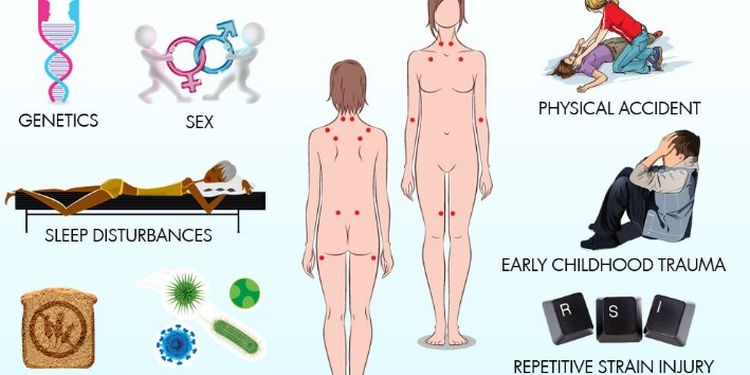Are You Ignoring The Signs of Fibromyalgia?
Have you ever woken up feeling a strange tingling in your hands and feet, or felt like your body was as stiff as a rock? Do you have a hard time concentrating due to constant stinging headaches located in the back of your neck? If you’ve been experiencing some of the above, along with a complete lack of energy– no matter how much you sleep- you could be facing some of the most common signs of fibromyalgia.
Fibromyalgia is a long-term disease that causes pain throughout the entire body, for reasons that are still up for debate. It’s also known as “chronic fatigue syndrome,” due to the overwhelming sense of tiredness that affects people who suffer from it. People with fibromyalgia often find themselves so chronically exhausted that they can barely handle even the smallest daily activities.

What Causes It?
Unlike some diseases where a single event triggers a negative response that affects the entire body, with fibromyalgia, it’s actually a series of symptoms or “stressors” that together contribute to the condition. These include severe brain or spinal cord trauma, stress, genetics, and in some rare cases, infection.

Why It’s So Hard to Diagnose
While most musculoskeletal conditions can be easily detected via x-ray, there are still no tests that can conclusively prove that a person is suffering from fibromyalgia. This is why it’s so hard to diagnose in its earlier stages. At the same time, because the symptoms are so similar, the fatigue and joint ache often have doctors mistaking fibromyalgia for arthritis. But the strongest symptom of fibromyalgia is the lack of energy due to constant fatigue, as well as depression or anxiety.

Common Misconceptions
Due to the lack of tests to help detect the disease, for a very long time, doctors considered fibromyalgia to be a non-existent condition. In other words, many patients suffering from it were told it was all “in their heads.” However, when the wrong diagnosis led to unsuccessful treatments and no relief from symptoms, doctors started to pay more attention to specific issues, such as muscle pain, chronic fatigue, and depression. Thus, this condition started to be taken very seriously in the medical community.

Chronic Muscle Pain, Muscle Spasms, or Tightness
Chronic muscle pain (also known as myofascial pain), spasms, and tightness are among the most common symptoms of fibromyalgia. When a doctor looks for the source of the pain (or trigger point), they’ll apply pressure on certain areas of your body. When instead of pressure you feel pain, that’s a symptom of the disease. It’s very important to note that these can only be considered symptoms if you’ve been experiencing them for at least three months in a row.

Fatigue and Decreased Energy
Fibromyalgia causes chronic exhaustion. This means that even the smallest daily task means a world of effort, and you never have enough energy to perform. Severe fatigue is one of the most distinct symptoms of fibromyalgia, and it’s closely related to a severe sleeping disorder– restless leg syndrome, a condition that causes a strong urge to move your legs to relieve anxiety and unpleasant feelings. This sleep disorder makes it hard to get comfortable and fall asleep.

Insomnia or Waking Up Feeling Tired
No matter how much you sleep, it’s never enough– that feeling becomes a part of your routine. You just can’t seem to get enough rest. If you’ve been experiencing this sleeping disorder for longer than two months, along with joint and muscle aches, make sure to see a doctor to receive appropriate treatment for fibromyalgia. Keep in mind that an adult needs between 7 and 9 hours of sleep. So how much are you really sleeping?

Stiffness Upon Waking or Staying Still Too Long
Directly related to joint pain, stiffness is also a common symptom of fibromyalgia. This horrible feeling is caused by your body mistaking signals your brain is sending about pain. After staying in the same position for an extended period of time, your body will have the reflex of going stiff, causing the excruciating pain experienced by most patients with fibromyalgia.

Difficulty Remembering, Concentrating, and Performing Simple Mental Tasks
Because the human brain is also a muscle, it’s deeply affected by fibromyalgia. Patients suffering from this condition often experience difficulty memorizing or even focusing, as well as performing simple mental tasks (such as addition and subtraction). This symptom within the illness is known as “fibro fog” due to its clouding effect on the patient’s ability to reason and think in general.

Abdominal Irritation or IBS
Patients who suffer from this condition often experience abdominal pain, nausea, and other typical symptoms of irritable bowel syndrome, like constipation and diarrhea. Acid reflux is also a recurrent symptom, so if you’re experiencing these symptoms, make sure to track your bowel movements and what could’ve led to being nauseous or bloated so you can discuss it with your doctor.

Tension or Migraine Headaches
Migraine headaches, a typical symptom suffered by 70% of people with fibromyalgia, are usually caused by pain in the upper section of the back and neck. Accumulated tension in the area causes tension-type headaches, which often hinder the patient’s ability to manage the disease. Headaches are also often caused by trigger points located in the back. If the pain is consistent for over three months, check with your doctor to be correctly diagnosed.

Jaw and Facial Tenderness
This means you most likely have difficulty opening your jaw completely to chew or speak. People with fibromyalgia regularly feel their jaws pop or make snapping noises when they open their mouths as a result of facial tenderness. This condition is medically known as temporomandibular joint syndrome (TMJ).

Sensitivity to Odors, Noise, Bright Lights
Imagine not being able to walk down the street because every single stimulus (from noisy cars to strong odors and bright lights) irritates you. This is an all-too-familiar feeling for people with fibromyalgia. Specialists believe the cause is related to a glitch in the way the brain perceives pain and any kind of trigger to the senses. Dr. Benjamin Natelson, a neurology professor at the Albert Einstein College of Medicine in New York City and author of Your Symptoms Are Real: What to Do When Your Doctor Says Nothing Is Wrong, found that in some cases, the brains of patients suffering from fibromyalgia may be too “hyper-responsive to even the possibility of pain or discomfort.”

Sensitivity to Medications, Certain Foods, and Cold
People with fibromyalgia tend to be extremely sensitive to medication and just about any change in the weather. Their chronic pain affects the way they perceive the world around them, as well as the food they ingest. The causes of this extreme sensitivity are still unknown, but most studies posit that they could be related to high levels of stress experienced by people who suffer from the condition.

Feeling Anxious or Depressed
According to a number of recent medical studies, anxiety and depression are some of the key symptoms of fibromyalgia. It could mostly be related to the constant pain the patient experiences in their whole body, which affects their emotions and psychological stability. When the pain is severe, physical activity decreases dramatically, which can deeply affect the patient’s self-esteem, and in turn, cause anxiety.

Numbness or Tingling in the Face, Arms, Hands, Legs, or Feet
These are all called “neurological complaints,” and people with fibromyalgia usually experience them along with morning stiffness. This crippling feeling is medically known as “paresthesia.” It usually lasts only a few minutes, but it’s a common symptom of the disease, so be wary.

Increase in Urinary Urgency or Frequency (Irritable Bladder)
Unlike fatigue and body pain, people with fibromyalgia experience incontinence and urinary urgency (to a lesser degree). Regardless, it’s a symptom that can be treated when diagnosed in a timely fashion. It’s important to keep in mind that fibromyalgia isn’t the only disease that causes an irritable bladder. A thorough test will help detect any other illnesses related to the same symptom, so don’t panic if you’re already experiencing this.

Reduced Tolerance for Exercise
As a result of the constant fatigue and lack of energy, people with fibromyalgia often have a low tolerance for exercise. And even when they do engage in physical activity, they’re in pain afterwards. This occurs because the brain of a person with fibromyalgia is misreading the level of pain that the body is actually experiencing. Fortunately, there’s an array of fibromyalgia-friendly exercises designed to counteract this ache. Get moving with physical therapy, loosen your muscles, and stretch your joints.

Feeling of Swelling in Hands and Feet (Without Actual Swelling)
If you suffer from fibromyalgia, you’re no stranger to the very disturbing feeling of your hands and feet swelling up. The weird part is, it’s just that– a feeling. This symptom is one of the most evident differences between fibromyalgia and arthritis. People with arthritis experience real swelling in their hands and feet, whereas in the case of those suffering from fibromyalgia, there’s no actual swelling taking place, as the feeling comes as a result of an excessive amount of stress.

Stronger Menstrual Pain in Women
One of the most unfortunate facts about fibromyalgia is that it affects 90% more women than men. To make matters worse, females suffering from fibromyalgia commonly experience significantly higher levels of pain during their menstrual cycle as a result of the aching the rest of their body suffers because of the disease. Very intense cramps are part of the condition.

Risk Factors of Fibromyalgia
The most common risk factors of fibromyalgia include gender– women are 90% more likely to suffer from it– and family history. Research indicates that it’s a disease that mostly passes on from mother to daughter, and people who suffer from other bone, joint, or muscle-related illnesses are more likely to suffer from fibromyalgia as well. An injury or any kind of trauma that causes stress is also a risk factor that increases a person’s chances of being diagnosed with this condition.

Trigger Points
There are 18 trigger points (or sources of pain) in the body, including the hips, knees, outer elbows and back of the head. Before a doctor can diagnose fibromyalgia, they need to make sure the patient suffers pain in at least 11 of the 18 known trigger points. The way to find out is by applying a very light dose of pressure on a trigger point. Where most people would just feel pressure, a person with fibromyalgia will feel a great deal of pain.

Traditional Course of Treatment
Upon receiving the diagnosis, a person with fibromyalgia needs to start treatment immediately, as the right treatment will minimize the pain and significantly improve their quality of life. But in order to get the appropriate treatment, you need to find the right doctor– preferably a rheumatologist or a specialist in fibromyalgia– and work specifically with them to improve your health.

Natural and Alternative Treatments
As there’s no cure for fibromyalgia, patients need to undergo treatment to deal with each symptom separately. For example, most people with fibromyalgia who suffer from insomnia and fatigue find aerobic exercise to be extremely helpful with their sleep routine. In terms of the trigger points, more patients are choosing alternative treatments like acupuncture to ease the pain while dealing with stress separately to improve their quality of life.

The Ideal Diet
If you’re suffering from fibromyalgia, it’s important to tailor your diet in such a way that your body is receiving all the nutrients it needs to cope with the disease. A balanced diet is the key to keep your system working– fruits and vegetables are a must. Hydration is paramount, and exercise is your ally. Keep in mind that the only way to fight chronic fatigue is to move. Stay active through physical therapy and make sure to watch your weight regularly.

Useful Tips
Many patients are taking to natural diets and supplements to minimize, and even reverse Fibromyalgia. Some of the most popular supplements include 5-HTP (serotonin, a powerful brain chemical that contributes to fighting depression and insomnia), and melatonin, which is mostly used to help improve sleep patterns. The first step toward overcoming this condition is believing (truly) that it doesn’t define you. It CAN be beaten, and with some lifestyle changes, dietary modifications, and optimism, you can absolutely be on the path to recovery.
